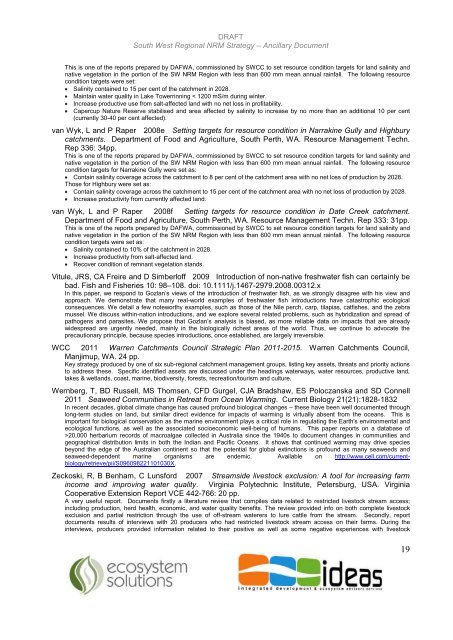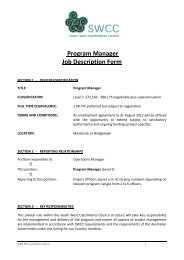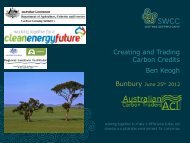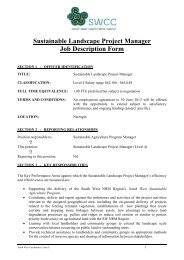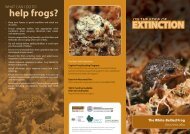Tender for the Programme - South West Catchments Council
Tender for the Programme - South West Catchments Council
Tender for the Programme - South West Catchments Council
You also want an ePaper? Increase the reach of your titles
YUMPU automatically turns print PDFs into web optimized ePapers that Google loves.
DRAFT<br />
<strong>South</strong> <strong>West</strong> Regional NRM Strategy – Ancillary Document<br />
This is one of <strong>the</strong> reports prepared by DAFWA, commissioned by SWCC to set resource condition targets <strong>for</strong> land salinity and<br />
native vegetation in <strong>the</strong> portion of <strong>the</strong> SW NRM Region with less than 600 mm mean annual rainfall. The following resource<br />
condition targets were set:<br />
Salinity contained to 15 per cent of <strong>the</strong> catchment in 2028.<br />
Maintain water quality in Lake Towerrinning < 1200 mS/m during winter.<br />
Increase productive use from salt-affected land with no net loss in profitability.<br />
Capercup Nature Reserve stabilised and area affected by salinity to increase by no more than an additional 10 per cent<br />
(currently 30-40 per cent affected).<br />
van Wyk, L and P Raper 2008e Setting targets <strong>for</strong> resource condition in Narrakine Gully and Highbury<br />
catchments. Department of Food and Agriculture, <strong>South</strong> Perth, WA. Resource Management Techn.<br />
Rep 336: 34pp.<br />
This is one of <strong>the</strong> reports prepared by DAFWA, commissioned by SWCC to set resource condition targets <strong>for</strong> land salinity and<br />
native vegetation in <strong>the</strong> portion of <strong>the</strong> SW NRM Region with less than 600 mm mean annual rainfall. The following resource<br />
condition targets <strong>for</strong> Narrakine Gully were set as:<br />
Contain salinity coverage across <strong>the</strong> catchment to 8 per cent of <strong>the</strong> catchment area with no net loss of production by 2028.<br />
Those <strong>for</strong> Highbury were set as:<br />
Contain salinity coverage across <strong>the</strong> catchment to 15 per cent of <strong>the</strong> catchment area with no net loss of production by 2028.<br />
Increase productivity from currently affected land.<br />
van Wyk, L and P Raper 2008f Setting targets <strong>for</strong> resource condition in Date Creek catchment.<br />
Department of Food and Agriculture, <strong>South</strong> Perth, WA. Resource Management Techn. Rep 333: 31pp.<br />
This is one of <strong>the</strong> reports prepared by DAFWA, commissioned by SWCC to set resource condition targets <strong>for</strong> land salinity and<br />
native vegetation in <strong>the</strong> portion of <strong>the</strong> SW NRM Region with less than 600 mm mean annual rainfall. The following resource<br />
condition targets were set as:<br />
Salinity contained to 10% of <strong>the</strong> catchment in 2028.<br />
Increase productivity from salt-affected land.<br />
Recover condition of remnant vegetation stands.<br />
Vitule, JRS, CA Freire and D Simberloff 2009 Introduction of non-native freshwater fish can certainly be<br />
bad. Fish and Fisheries 10: 98–108. doi: 10.1111/j.1467-2979.2008.00312.x<br />
In this paper, we respond to Gozlan’s views of <strong>the</strong> introduction of freshwater fish, as we strongly disagree with his view and<br />
approach. We demonstrate that many real-world examples of freshwater fish introductions have catastrophic ecological<br />
consequences. We detail a few noteworthy examples, such as those of <strong>the</strong> Nile perch, carp, tilapias, catfishes, and <strong>the</strong> zebra<br />
mussel. We discuss within-nation introductions, and we explore several related problems, such as hybridization and spread of<br />
pathogens and parasites. We propose that Gozlan’s analysis is biased, as more reliable data on impacts that are already<br />
widespread are urgently needed, mainly in <strong>the</strong> biologically richest areas of <strong>the</strong> world. Thus, we continue to advocate <strong>the</strong><br />
precautionary principle, because species introductions, once established, are largely irreversible.<br />
WCC 2011 Warren <strong>Catchments</strong> <strong>Council</strong> Strategic Plan 2011-2015. Warren <strong>Catchments</strong> <strong>Council</strong>,<br />
Manjimup, WA. 24 pp.<br />
Key strategy produced by one of six sub-regional catchment management groups, listing key assets, threats and priority actions<br />
to address <strong>the</strong>se. Specific identified assets are discussed under <strong>the</strong> headings waterways, water resources, productive land,<br />
lakes & wetlands, coast, marine, biodiversity, <strong>for</strong>ests, recreation/tourism and culture.<br />
Wernberg, T, BD Russell, MS Thomsen, CFD Gurgel, CJA Bradshaw, ES Poloczanska and SD Connell<br />
2011 Seaweed Communities in Retreat from Ocean Warming. Current Biology 21(21):1828-1832<br />
In recent decades, global climate change has caused profound biological changes – <strong>the</strong>se have been well documented through<br />
long-term studies on land, but similar direct evidence <strong>for</strong> impacts of warming is virtually absent from <strong>the</strong> oceans. This is<br />
important <strong>for</strong> biological conservation as <strong>the</strong> marine environment plays a critical role in regulating <strong>the</strong> Earth's environmental and<br />
ecological functions, as well as <strong>the</strong> associated socioeconomic well-being of humans. This paper reports on a database of<br />
>20,000 herbarium records of macroalgae collected in Australia since <strong>the</strong> 1940s to document changes in communities and<br />
geographical distribution limits in both <strong>the</strong> Indian and Pacific Oceans. It shows that continued warming may drive species<br />
beyond <strong>the</strong> edge of <strong>the</strong> Australian continent so that <strong>the</strong> potential <strong>for</strong> global extinctions is profound as many seaweeds and<br />
seaweed-dependent marine organisms are endemic. Available on http://www.cell.com/currentbiology/retrieve/pii/S096098221101030X.<br />
Zeckoski, R, B Benham, C Luns<strong>for</strong>d 2007 Streamside livestock exclusion: A tool <strong>for</strong> increasing farm<br />
income and improving water quality. Virginia Polytechnic Institute, Petersburg, USA. Virginia<br />
Cooperative Extension Report VCE 442-766: 20 pp.<br />
A very useful report. Documents firstly a literature review that compiles data related to restricted livestock stream access;<br />
including production, herd health, economic, and water quality benefits. The review provided info on both complete livestock<br />
exclusion and partial restriction through <strong>the</strong> use of off-stream waterers to lure cattle from <strong>the</strong> stream. Secondly, report<br />
documents results of interviews with 20 producers who had restricted livestock stream access on <strong>the</strong>ir farms. During <strong>the</strong><br />
interviews, producers provided in<strong>for</strong>mation related to <strong>the</strong>ir positive as well as some negative experiences with livestock<br />
19


